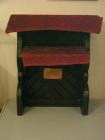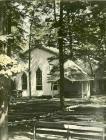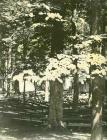14
The Auditorium, a natural amphitheatre formed by the ground sloping slightly downwards from the outer edge of the circle, was used as a meeting place. The wooden preachers' stand was used until 1888. Behind it was a small building used for storage that also held bunks to be used in an emergency for a place to sleep. From the preachers' stand you could see the backless seats in the Auditorium for the worshippers. Backs were added around 1876. The seats were thick boards laid length-wise and supported underneath by logs. When the ground was damp, clean straw was spread to make it more comfortable. Overhead the branches of the forest trees formed a canopy.16
Original pulpit used in the original Preachers' Stand in the outdoor Auditorium and later in the Temple at Grimsby Park. The pulpit is now in the permanent collection of the Grimsby Museum.18
In December 1875, the Directors approved the construction of the Tabernacle and it was built behind the preachers' stand. The Tabernacle was 58' x 86' and 16' high and was used during inclement weather for church services. In 1888, the open concept Auditorium was replaced by the Temple and the Tabernacle was demolished.20
On August 9, 1876, the Board of Directors approved a motion "that the Tabernacle in the Auditorium be seated with seats with backs as soon as possible and as cheaply as possible".21
A quote from Harriet Phelps Youmans' book "Grimsby Park: Historical and Biographical Sketches"."At night the scene was lighted by fires of pine knots and roots, burning upon the six high, square platforms which were placed at intervals around the circle. They were supported on stout posts and were five or six feet high. Strong wooden floors, covered with a foot or more of soil (out of which the grass grew only to blacken and die at meeting time), supported these primitive torches. These fires served a double purpose; they lighted the place very satisfactorily, and the heat counteracted the dampness of the evening air, which was seldom noticed during the long evening meetings."


